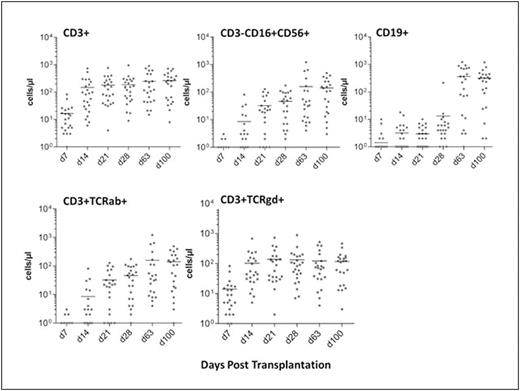Abstract
We report the first prospective, multi-center, open-label, single-arm phase I/II clinical trial that assesses the safety and feasibility of stem cell transplantation with TCRalpha/beta and CD19-depleted haploidentical grafts generated with the CliniMACS plus System (Miltenyi Biotec, Germany) in combination with a reduced-intensity conditioning in pediatric patients suffering from various malignant and non-malignant diseases (www.clinicaltrialsregister.org; 2011-005562-38). All patients received single agent MMF as short-term GVHD prophylaxis (40mg/kg/day for 30 days). The speed of immune reconstitution was measured in two core labs using standardized methods and the MACSQuant flow cytometry device (Miltenyi Biotec, Germany).
Results: Thirty patients from six hospitals were treated (13 female, 17 male; median age 7 years, range 1 - 17 years). Of the 30 recipients, 10 had ALL, 8 had AML, 6 had solid tumors (soft tissue sarcomas and neuroblastomas), 3 had MDS/MPS, and 1 each with lysosomal storage disorder, SCID, and Wiskott Aldrich syndrome. Disease status in acute leukemias/MDS was: CR1 (n=4), relapsed/refractory (n=17). 5/6 patients with solid tumors had relapsed metastatic disease. The conditioning regimen consisted of 15 or 30 mg ATG (Fresenius/Grafalon) or 7 Gy total nodal irradiation, 160 mg/m2 fludarabine, 10 mg/kg thiotepa, and 140 mg/m2 melphalan. The median number of CD34+ cells, TCRalpha/beta+ cells and CD20+ cells infused was 14.6 x 106 (range, 4 - 54.9), 14 x 103 (range, 0.62 - 40.6) and 0.55 x 105 (range, 0.04 - 1.85), respectively. In addition, significant numbers of NK and TCRgd+ cells/kg were infused - 6.67 x 107 (median; range, 0.68 - 18.2) and 1.58 x 107 (median; range, 0.13 - 4.7), respectively. All 30 patients tolerated the infusion of haploidentical stem cell grafts well. Twenty-five patients had primary engraftment of ANC > 500 cells/µL at a median of 12 days (range, 10 - 18) and PLT > 20,000 cells/µL at a median of 15 days (range, 11 - 27). Peripheral T-cell chimerism at the time of engraftment was completely donor in 19/25 patients (76%), mixed in 3 (12%), and not measured in three. Five patients experienced primary graft failure and 2 had secondary graft failure. All except of one were successfully re-transplanted.
None of the recipients developed severe acute GVHD grades III - IV. Only 1 patient had acute GVHD grade II that started on day 22. The vast majority of patients (96.7%) experienced no or only grade I acute GVHD despite minimal GVHD prophylaxis after transplantation.
Samples from 24/25 patients with primary engraftment were evaluable for immune reconstitution (Figure 1). On day 28, the majority of WBC were NK cells (median 309 cells/µL; range, 64 - 1026). The second main type of cells were CD3+ cells (median 151 cells/µL; range, 9 - 953), mostly TCRgd+ (median 87 cells/µL; range, 7 - 891). At day 100, TCRab+ cells equalled TCgd+ cells (median 108 vs. 116 cells/µL). B cells recovered more slowly, with a median of 255.5 cells/µL (range, 1 - 1218) on day 63.
ADV reactivation contributed most to infectious complications following transplantation. In total, 16/30 patients had ADV DNAemia or were positive in stool. Additionally, seven patients were tested positive for CMV (blood or urine). BK virus was present in 5 patients with 3 patients experiencing cystitis. No EBV reactivation was observed. Two patients had bacterial sepsis, 1 moderate, 1 fatal (due to non-engraftment).No fatal viral infection occurred within 100 days.
One molecular relapse was observed within 100 days post transplantation that was treated with blinatumomab. Two of the 30 transplanted patients died within 100 days after transplantation: 1 patient due to sepsis following graft failure (non-relapse mortality) and 1 due to relapse. On day 100, chimerism was completely donor in 20 patients and mixed in two.
Conclusions: The CliniMACS depletion system of TCRab+ and CD19+ cells yielded a large number of CD34+ cells, NK cells and TCRgd+ cells, that could be infused safely into pediatric patients with minimal risk of severe acute GVHD. The immune reconstitution was rapid and there was no TRM associated with viral or fungal infections. Coupled with a reduced-intensity regimen, the overall TRM was low. Longer follow up will provide essential information on chronic GVHD and survival outcomes.
Immune Reconstitution after transplantation of TCR-alpha/beta and CD19 depleted haploidentical stem cell grafts
Immune Reconstitution after transplantation of TCR-alpha/beta and CD19 depleted haploidentical stem cell grafts
Bader:Riemser: Research Funding; Neovii Biotech: Research Funding; Servier: Consultancy, Honoraria; Novartis: Consultancy, Honoraria; Medac: Consultancy, Research Funding. Karitzky:Miltenyi Biotec: Employment. Holtkamp:Miltenyi Biotec: Employment. Siewert:Miltenyi Biotec: Employment. Bönig:Miltenyi Biotec: Consultancy, Honoraria, Research Funding. Handgretinger:Miltenyi Biotec: Patents & Royalties: Co-Patentholder of TcRalpha/beta depletion technology.
Author notes
Asterisk with author names denotes non-ASH members.


This feature is available to Subscribers Only
Sign In or Create an Account Close Modal